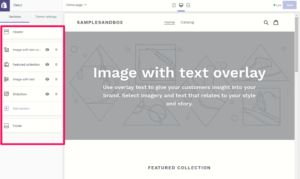Without a doubt, dropshipping is a hot topic among Shopify entrepreneurs. The main reason for this is probably Shopify’s ease of use and seamless integrations with Oberlo, Spocket, Modalyst, and similar apps that facilitate dropshipping. Maybe you’re one of the people who want to get into dropshipping and wonder how to start and differentiate yourself from the crowd.
We will share you our knowledge of setting up a Shopify store and then, we will cover some ways you can scale your dropshipping store. Let’s go.
How to recognize a dropshipping store on Shopify?
Dropshipping is attractive because vendors don’t store their merchandise onsite. Every product is shipped directly from the warehouse, either a direct manufacturer or a storage. Dropshipping vendors act as intermediaries between the buyer and the supplier. They use website, social media marketing and ads to advertise their products. When someone places an order, dropshippers pass it on to the warehouse. Their job is done. But can you tell from the store itself that a shop is a dropshipping business?
There’s not much you can tell from the storefront. Professional dropshipping stores, especially the ones that run on Shopify, look well-polished and trustworthy. Yet, if you read their shipping policy, check their shipping rates or check their products against Google Search, you’re able to tell that a store doesn’t have their own inventory. Slow ship time, products that can be found on AliExpress or disclaimers about possible custom charges when shipping outside the borders.
Another tell-tale sign that an e-commerce site does business in a dropshipping model is checking the apps on the site using BuiltWith. Type in the URL into BuiltWith and check if the webpage has Oberlo, uDroppy, Spocket, CJDropshipping or any other dropshipping app that’s on the Shopify App store.
Yet, you still can enter the dropshipping business and create a successful online store. We will explain you exactly what you need and give you tips on how to open up such a store on Shopify.
What do you need for dropshipping?
Dropshipping can be great if you want to set foot in e-commerce or test an idea for a product without much investment. Some stores are based entirely on dropshipping model while other businesses dropship a few products, just to be able to tell if these products are worth investing in. No matter what your intentions are for your store, the steps we’re about to share will come in handy to you.
1. Pick a dropshipping niche and target market
Most successful e-commerce companies focus on specific niches. It’s way easier to build a successful strategy once you know your product category. The other thing you need to do at this point is to find a target market. It goes hand in hand with picking the niche. If you want to go into the fashion niche, you can target people based on their gender, age and/or the lifestyle they tend to have.
What’s important is that you pick a niche that continues to sell products over time as opposed to a trendy one. Trends come and go, but if you aim at building a long-standing shop that stays popular through the years, you can build something special. How to make sure that a shop is not just a fad? Check its popularity on Google Trends – it’s a well-known tool that shows how many searches is run for a specific keyword (for example dog accessories). Perfect for those of you who are looking to expand their shop inventory. Likewise, it’s very useful when you’re trying to tell a difference between a stable trend and a fad that is just about to go out of fashion.
What else can you do to make sure the niche you’re about to go into is worth your attention? Check social media posts, audience sizes, likes, inspect hashtags, look into popular Reddit and Quora threads – anything that gives you hints about the popularity of the niche. Moreover, see if there’s any competition. That’s a sign that you’re making a good decision because it means that you’re not the only person who believes in that niche.
But what if it’s a growing niche (or a very small one) and you have no one to compare yourself to? In such a case, you can try setting up a simple landing page, run some ads and see if your target market gets interested in that.
2. Find a (profitable) product
There’s no need for you to have a large portfolio of products. Quite contrary. Common advice for Shopify dropshipping store is to start with one product for a very tight niche and grow your store from there. There are many Shopify stores that sell only one product that has a few variations. That’s pretty clear, but how to find the right product to start with? You can take into consideration three things: product popularity, enthusiasm you have for a product and quality of your supplier.
Product popularity
Some dropshippers look for a relevant product on AliExpress, Amazon or straight in a dropshipping app (Oberlo, uDroppy, etc.). When it comes to AliExpress, check the order volume of a product. Be careful about best-selling lists. Chances are those products are just fads or they are over-saturated with competition. To check if that’s a case, search for the product on Google (either by typing its name or through pasting its picture on Google Image) or through Google Keyword Planner.
You can also look for a product inspiration on Amazon. You can get a lot of product ideas by scrolling down their home page. Don’t look for exact matches, but rather explore what direction you should explore. For example, the quarantine made kitchenware and gym equipment super popular. See what items are promoted by Amazon. Can you find an untapped product ideas for a dropshipping business there?
Enthusiasm you have for a product
How to decide on a product? There’s a simple tip. While searching for a perfect product to sell, think about a way of showcasing it to the world. If your mind is blank and you suffer to think of anything, look for another product. Ideally, product descriptions, clever promotional strategies and targeting tips should pop into your head right after you set your eyes on the product. It is a sign that you have stumbled upon the right thing to sell.
Why is that so? You will spend much time promoting that product. Only a handful of dropshippers can make a sale while not being interested in their product. The rest of us will struggle to sell the product we don’t see a value of. And ultimately, it can kill our chance of creating a high-performing shop.
Quality of supplier
The success of your dropshipping business depends on to a great extent on your supplier. If you pair up with someone who is reliable, you don’t have to worry about shipping. Yet, if you choose a company that doesn’t care about customer satisfaction, plus their shipping time is long and unpredictable, you’re up for a challenge. You may struggle with angry customers who leave bad reviews on your site or spam your inbox with emails that you wouldn’t have to deal with if you found a quality business partner. Fortunately, most apps that help with Shopify dropshipping, such as Oberlo or uDroppy, have a Seller Ratings inside their app. You can even use the ratings as a filtering option when looking for the best product to sell (Sort by Seller Rate).
Before choosing the supplier, make sure to check their shipping time. It’s a no-brainer that a shorter shipping time is better. Nonetheless, not everybody knows that the shipping time may differ between suppliers. Sometimes paying an extra dollar or a few more cents means that your product may be delivered way faster. It should be noted that it’s useful to check out products on more than one dropshipping app. Why? Sometimes the shipping fee is way cheaper in the other one. So, don’t hesitate to explore more than one app at the time.
3. Work on branding
Now that you know what niche you’re going into and you found your product, it’s time to work on the branding of your dropshipping business. Store branding is important and it goes far beyond a look and feel of your store and social media profiles. Branding touches everything. The way you communicate with your customer, how you make them feel, what kind of world you imagine and what values you cherish. Everything you do is a reflection of your brand and leaves an impression on your consumer. Do a good job and you will earn a loyal crowd of customers who either refer you further or come back to buy more.
The most common question at this point is “Isn’t branding just for stores who sell their original products?” No, it isn’t. Branding is the secret ingredient that will make your dropshipping business unique, attractive and hard to forget. It promises value that is more than just purchasing a product. It sets you apart from the vendors that offer the same product or similar ones.
A common exercise that is used when making a brand is to imagine it as a real person.
- What would this person wear?
- How they would look like?
- What are they like?
- How would they talk?
- What are they interested in?
- What’s their sense of humor?
In other words, it’s recommended to build an avatar that set the tone for your brand. Once you do this exercise, you will spot that most brands can be pigeonholed as certain types of people. From very serious to incurable pranksters. Those who enjoy spending time with their families to those driven by their careers and making profit. If you struggle to come up with anything, explore brand archetypes framework. It should clear things up for you.
That’s the only one piece of the puzzle. Brand building also involves steps below.
- Write brand purpose, mission & vision statements – you need to establish why, what and how of your brand, which essentially feeds your entire strategy.
- Name your brand – if your mind is blank, use one of the free generators online; Shopify has one but you can use other tools, such as Namesnack, just remember to check the domain availability before committing to a name.
- Pick colors & imagery – having a unified brand image is important. It shows professionalism and care; apart from picking colors for your brand (you can get a cohesive color palette with online tools, e.g., Adobe), pick imagery that represents your brand (here’s a helpful article about choosing the right pictures).
- Define language & tone – product descriptions, customer emails and social media posts should all be based on a kind of language that matches your brand personality.
- Create a logo – Shopify has its own logomaker called Hatchful that you can use when creating a logo for your dropshipping store. There are a ton of templates that you can customize to your brand.
The harder you work at this point, the higher the chance that shop visitors choose you over your competition. And if your brand matches their lifestyle, reflect their values and earns their trust, you can grow your dropshipping store beyond your initial expectations. For logo, naming, imagery inspiration, we recommend you checkout Best Designs. Look at the featured work and get ideas of what you can do on your own.
4. Set up a Shopify store
It’s time to set up your Shopify shop. Either go to the main page or register a store with this link to test Shopify for 3 days for free. Now, you have a shop. As default, you get a domain that ends with myshopify.com. You need to buy a domain or connect the one you already own so that you don’t have “myshopify” in your URL.

- Oberlo
- uDroppy
- Spocket
- Dripshipper
- CJDropshipping
- Modalyst
- pricing
- customer service
- product range
- size inventory updates
- product order
- tracking order processing: manual or automatic?
5. Bring traffic to your Shopify store
WHO aka target audience
WHERE aka marketing channels
- social media (Instagram, Twitter, Facebook, TikTok)
- paid advertising (ads on social media or via search engines)
- email marketing
- referral marketing (press mentions, influencer marketing)
- website marketing (using your own website, running a blog)
- Search Engine Optimization (SEO)
WHAT aka marketing message
Additional selling points as a way to market your dropshipping business
6. Optimize for conversions
➡️ Shopify apps that increase conversions
What are those apps?
- collecting social proof – collecting product reviews is one of the e-commerce industry’s best practice; visitors can see that they’re not the only people interested in the product, but in fact, other people have bought it and shared their experience on the site. Plus, many Shopify apps like Loox import reviews directly from AliExpress products, so you don’t need to collect them manually.
- running remarketing campaigns – sometimes people leave your store without buying and that’s okay; the problem starts when they put an item to the cart, but they don’t complete the order. Don’t worry. You can reach out to them by sending card abandonment emails or targeting them with a remarketing campaign that features the products they left in their cart. See Care Cart or AdMonks for that.
- upselling & cross-selling products – to increase the average cart value and get more profit from a single order, think about the ways of upselling or cross-selling your products – apps like ReConvert or SellUp make it easy to set up.
- seasonal discounts – if done smart, discounting can bring you more profit than loss. Shopify helps you set up discounts right in the admin panel. Yet, don’t over-relay on discounting as you can transform yourself into a discount brand.


